The global self-propelled transport barge market is forecast to reach USD 9.7 billion by 2035, reflecting an absolute increase of USD 3.0 billion over the forecast period. The self-propelled transport barge market is valued at USD 6.7 billion in 2025 and is expected to grow at a CAGR of 3.7%. This growth is driven by the increasing demand for efficient and cost-effective transportation solutions for bulk goods across inland waterways and coastal regions. Self-propelled transport barges, which do not require external towboats, are ideal for transporting large quantities of goods over long distances while minimizing operational costs.
Self-propelled transport barges are typically used for the transportation of bulk commodities such as coal, grain, chemicals, and other heavy goods. They offer significant advantages in terms of fuel efficiency and operational flexibility compared to traditional towing methods. As the global demand for sustainable and efficient freight transportation grows, self-propelled barges are becoming increasingly popular for their ability to move large volumes of cargo in a cost-effective and environmentally friendly manner. The growth of inland waterway transport, particularly in regions with well-established river networks such as Europe, North America, and parts of Asia, is further propelling the demand for these barges.
Technological advancements, including improved engine designs, better fuel efficiency, and enhanced automation systems, are also contributing to the market expansion. Stricter regulations surrounding emissions and environmental sustainability are encouraging the adoption of greener, more energy-efficient transportation methods, driving the demand for modern self-propelled barges that can meet these standards.
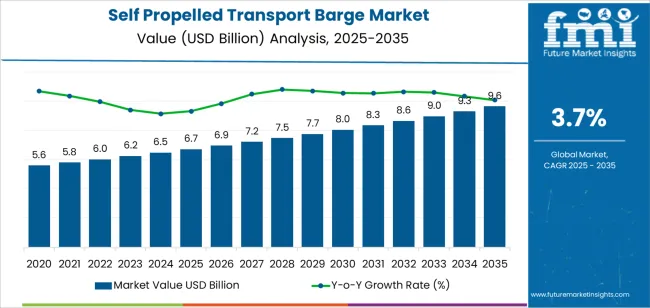
Between 2025 and 2030, the self-propelled transport barge market is projected to grow from USD 6.7 billion to approximately USD 8.0 billion, adding USD 1.3 billion, which accounts for about 43.3% of the total forecasted growth for the decade. This growth will be driven by the ongoing expansion of inland waterway transport networks and the rising demand for cost-effective and efficient freight solutions. As global supply chains continue to demand reliable, sustainable methods for transporting bulk goods, self-propelled transport barges, which offer greater fuel efficiency and flexibility compared to traditional towing methods, are becoming more popular in regions with well-established river systems like Europe, North America, and parts of Asia.
From 2030 to 2035, the market is expected to expand further from approximately USD 8.0 billion to USD 9.7 billion, adding USD 1.7 billion, which constitutes about 56.7% of the overall growth. This phase will be marked by a stronger adoption of self-propelled barges due to increasing environmental regulations and the need for more sustainable transportation solutions. The demand for greener freight transportation will push for energy-efficient self-propelled barges capable of meeting stricter emissions standards. The growing industrial activity and trade in emerging regions will further accelerate the demand for such barges as businesses seek reliable and eco-friendly methods to transport bulk cargo over long distances.
| Metric | Value |
|---|---|
| Market Value (2025) | USD 6.7 billion |
| Market Forecast Value (2035) | USD 9.7 billion |
| Forecast CAGR (2025-2035) | 3.7% |
The self-propelled transport barge market is growing due to the increasing demand for efficient and cost-effective transportation solutions in the maritime industry. Self-propelled transport barges are crucial for the movement of goods across waterways, especially in regions with significant inland waterway systems. These barges offer advantages over traditional transport methods by providing increased flexibility and reducing dependency on tugs, which can lower operational costs and improve scheduling efficiency.
The growth in global trade, particularly in bulk goods such as coal, grain, and construction materials, is driving the demand for self-propelled transport barges. These vessels are well-suited for transporting large quantities of cargo over long distances, especially in regions like Europe, North America, and parts of Asia, where inland waterway transportation plays a key role in supply chain logistics. The efficiency and reduced fuel consumption of self-propelled barges compared to other forms of transportation, like road or rail, make them an attractive option for many industries.
The focus on reducing transportation costs and improving environmental sustainability in the maritime sector is promoting the adoption of self-propelled barges. As these vessels are designed to handle large loads with relatively lower emissions, they align with the growing emphasis on green logistics and sustainability in the shipping industry. The market faces challenges such as the high initial capital investment required for purchasing these vessels and regulatory requirements related to environmental standards, which could impact growth in certain regions.
The market is segmented by type, application, and region. By type, the market is divided into deadweight >1000 tons and deadweight ≤1000 tons, with deadweight >1000 tons leading the market. Based on application, the market is categorized into cargo transportation, marine engineering, and environmental management, with cargo transportation representing the largest segment in terms of market share. Regionally, the market is divided into Asia Pacific, Europe, North America, and other key regions.
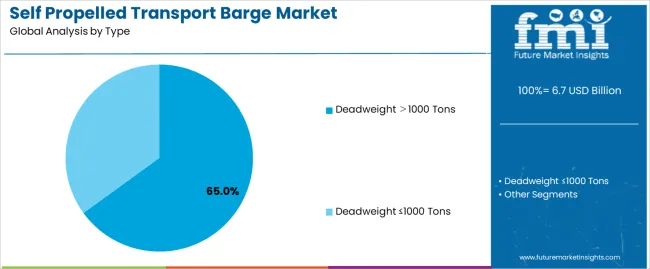
The deadweight >1000 tons segment leads the self-propelled transport barge market, accounting for approximately 65.0% of the total market share. This segment’s growth is driven by the increasing demand for larger, more efficient barges capable of carrying heavier and bulkier loads across various maritime routes. Barges with a higher deadweight capacity are particularly suited for large-scale cargo transportation, including industrial materials, bulk commodities, and heavy equipment, making them a preferred choice for shipping companies involved in global trade and logistics.
Larger barges also offer greater operational efficiency, as they allow for more cargo to be transported per trip, reducing overall transportation costs. Advancements in engine technology and hull design have enhanced the fuel efficiency and reliability of these larger barges, further boosting their demand. The rise in global trade, coupled with growing infrastructure development projects that require large-scale material transportation, is expected to continue driving growth in this segment. As industries seek more cost-effective and scalable shipping solutions, deadweight >1000 tons barges are anticipated to maintain their dominance in the self-propelled transport barge market.
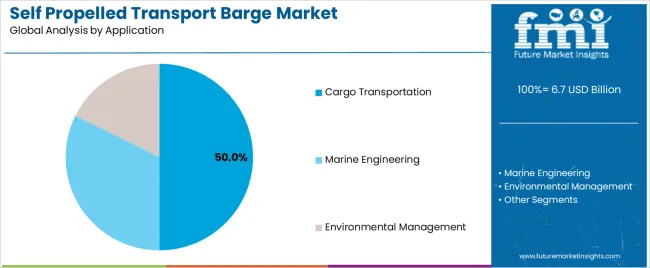
The cargo transportation application dominates the self-propelled transport barge market, holding 50.0% of the total market share. This dominance is driven by the critical role that self-propelled barges play in transporting goods across inland waterways, coastal regions, and international shipping lanes. The growing demand for efficient, large-scale cargo transportation, especially for bulk commodities like coal, grain, and construction materials, has significantly boosted the demand for self-propelled transport barges. These barges provide a cost-effective and reliable solution for moving large quantities of goods, particularly in regions where water transport is more economical than land-based methods.
The expansion of global trade and the need for specialized transport solutions for oversized or heavy cargo are key drivers of growth in the cargo transportation segment. Self-propelled transport barges are particularly advantageous for industries that rely on heavy or bulky shipments that cannot be efficiently moved by traditional trucks or ships. As the demand for global and regional logistics increases, the cargo transportation segment is expected to continue dominating the market, fueled by the continued reliance on maritime transport for large-scale goods movement.
The market is expanding due to the increasing demand for self‑propelled transport barges in mining, dredging and bulk‑cargo operations across inland waterways and coastal routes. These vessels offer features like onboard propulsion systems (enabling independent movement), enhanced maneuverability, and reduced reliance on external tugs. Key drivers include rising infrastructure and dredging activities, growth in bulk material transport and enhanced waterway logistics, while restraints stem from high upfront vessel costs and regulatory and environmental hurdles.
Why are Self‑Propelled Barges Gaining Popularity in Transport Applications?
Self‑propelled barges are gaining popularity because they offer greater operational flexibility and efficiency compared to traditional towed barges. With their own propulsion systems, these barges reduce the dependency on tugboats, which shortens turnaround times and improves operational speed. Self‑propelled barges enable access to more challenging or remote waterways, providing a competitive edge in navigating areas that are difficult to reach with traditional vessels. As industries such as mining, construction, and logistics expand their inland operations and bulk cargo transportation, self‑propelled barges offer significant advantages in terms of autonomy and cost‑efficiency. The global demand for more efficient and environmentally friendly transport solutions, especially in regions where road and rail infrastructure is limited, further boosts the adoption of self‑propelled barges. Their ability to reduce logistical bottlenecks and offer streamlined transport options is driving their increasing popularity in various transport sectors.
How are Technological and Infrastructure Innovations Driving Growth in This Market?
Technological and infrastructure innovations are driving growth in the self‑propelled barge market by improving vessel designs, propulsion systems, and overall operational logistics. Advances in engine technology and automation have led to barges with better fuel efficiency, lower operating costs, and reduced manpower requirements, making them more appealing for both operators and environmental compliance. The expansion of inland waterways, port upgrades, and investments in dredging infrastructure have made it easier for self‑propelled barges to operate efficiently across a wider range of routes and conditions. Modular vessel designs and the use of improved materials allow for greater customization, enabling barges to be tailored for specific purposes such as bulk cargo, dredging, or transport. These innovations increase the functionality and adaptability of self‑propelled barges, broadening their applications and contributing to the growing demand for these vessels in various industrial sectors, ultimately supporting market growth.
What are the Key Challenges Impacting the Adoption of Self‑Propelled Barges?
One of the primary challenges is the high initial capital cost. Compared to towed barges, self‑propelled vessels are more expensive due to their advanced propulsion systems, control mechanisms, and maintenance needs. Regulatory and environmental constraints are also significant barriers emission standards, waterway restrictions, and dredging permits can drive up compliance costs and delay the deployment of new vessels. Fluctuations in commodity markets and the unpredictable demand for bulk materials can lead to uncertainty regarding the profitability and utilization of self‑propelled barges. The readiness of infrastructure such as navigable waterways, ports, and logistical support is crucial for the efficient use of these barges. For smaller operators or companies in emerging regions, these challenges can limit their ability to invest in and deploy self‑propelled barges on a large scale.

| Country | CAGR (%) |
|---|---|
| China | 5.0% |
| India | 4.6% |
| Germany | 4.3% |
| Brazil | 3.9% |
| USA | 3.5% |
| UK | 3.1% |
| Japan | 2.8% |
The self-propelled transport barge market is growing steadily across the globe, with China leading at a 5.0% CAGR, driven by its large-scale manufacturing, trade infrastructure, and extensive river and waterway networks. India follows with a 4.6% CAGR, fueled by the country’s increasing demand for bulk transportation solutions and growing investments in inland waterways. Germany experiences a 4.3% CAGR, supported by its strong industrial base and efficient logistics infrastructure that relies on water transport. Brazil shows a 3.9% CAGR, benefiting from its large river networks and the ongoing expansion of its transportation sector. The USA grows at a 3.5% CAGR, driven by its extensive inland waterway system and increasing use of barges for bulk cargo transport. The UK’s market grows at a 3.1% CAGR, bolstered by sustainable transport initiatives and a shift toward more cost-effective and eco-friendly transportation solutions. Japan shows a 2.8% CAGR, driven by its maritime trade sector and increasing investments in efficient transport systems.
China is leading the self-propelled transport barge market with a 5.0% CAGR, driven by its extensive use of waterways for domestic trade and logistics. The country has a well-established network of rivers, canals, and coastal routes, which are vital for transporting bulk goods, particularly in regions like the Yangtze River and the Pearl River Delta. Self-propelled barges play a crucial role in facilitating efficient, cost-effective transportation of raw materials, chemicals, coal, and other bulk cargo. As China’s manufacturing sector continues to expand and international trade remains a priority, the demand for reliable water-based transport systems like self-propelled barges grows.
The Chinese government’s efforts to modernize inland waterway infrastructure and improve shipping efficiency also drive market grzowth. Investments in port facilities, logistics hubs, and cargo handling technologies are expected to increase the adoption of self-propelled barges, which are becoming more integral to the country's supply chain system. The increasing need for eco-friendly and energy-efficient transportation solutions, combined with China's goal to reduce carbon emissions, is leading to the development of greener self-propelled barges. As the demand for more sustainable transport solutions increases and China’s inland waterway network expands, the self-propelled transport barge market will continue to grow in this region.
India is experiencing solid growth in the self-propelled transport barge market, with a 4.6% CAGR, fueled by the country’s efforts to improve its inland waterways for freight transport. The government has been investing in the development of its National Waterways and other river-based transportation projects to improve logistics efficiency and reduce dependence on road and rail transport. The need for bulk transportation solutions for commodities like coal, fertilizers, and construction materials is increasing, and self-propelled barges are being utilized to transport goods efficiently across the country’s extensive river systems, including the Ganges and Brahmaputra rivers.
As the Indian government continues to prioritize water-based transportation under its “Sagarmala Project,” which aims to promote port-led development and efficient inland waterway systems, the demand for self-propelled barges is expected to grow. The reduction in carbon emissions from using water transport over road and rail has made barges an attractive alternative in India’s growing logistics sector. As India’s manufacturing and construction sectors expand, the need for cost-effective, bulk cargo transport will continue to increase. These factors, combined with increasing government investments in port infrastructure and logistics technology, are supporting the growing adoption of self-propelled transport barges in the country.

Germany is contributing significantly to the self-propelled transport barge market with a 4.3% CAGR, supported by its strong industrial base and highly developed inland waterways. The country’s rivers, such as the Rhine, Elbe, and Danube, are critical for transporting goods like coal, oil, chemicals, and manufactured products. Self-propelled barges are essential in facilitating the efficient movement of bulk cargo across Germany's extensive inland waterway network. As Germany continues to prioritize sustainability and energy efficiency in its transportation system, the demand for self-propelled barges is growing, particularly those designed with eco-friendly technologies and low fuel consumption.
The increasing emphasis on sustainable logistics and the rising cost of land transport is contributing to the expansion of waterborne freight transportation in Germany. The country's robust trade and manufacturing sectors require reliable and efficient transport solutions for large volumes of goods, which self-propelled barges offer. Moreover, Germany’s strong position as a hub for international trade within the European Union is further boosting demand for barges as a cost-effective and environmentally friendly alternative to road transport. With ongoing investments in infrastructure and the adoption of smart shipping technologies, Germany’s market for self-propelled transport barges is set to continue growing, solidifying its place as a key player in Europe’s waterborne logistics industry.
Brazil is witnessing steady growth in the self-propelled transport barge market, with a 3.9% CAGR, driven by the country's significant river networks and increasing demand for bulk transportation. The Amazon River and other major waterways in Brazil serve as vital transportation routes for commodities like soybeans, iron ore, coal, and agricultural products. As Brazil looks to expand its infrastructure, self-propelled barges are becoming a central solution for moving goods efficiently across the country’s vast river systems. With an emphasis on reducing road traffic and environmental impact, Brazil is increasingly turning to waterborne transport as a sustainable alternative.
The Brazilian government’s focus on infrastructure development, particularly for its inland waterways, is also helping drive the adoption of self-propelled transport barges. Initiatives such as the “Waterway Transport Program” aim to modernize Brazil's logistics and reduce congestion on road and rail systems. The increased demand for efficient and environmentally friendly transport solutions, along with Brazil’s reliance on bulk exports, is fueling growth in this sector. As the logistics landscape in Brazil evolves with modernized ports, improved waterways, and more streamlined supply chains, the self-propelled transport barge market is expected to grow, supporting the country’s economic expansion.
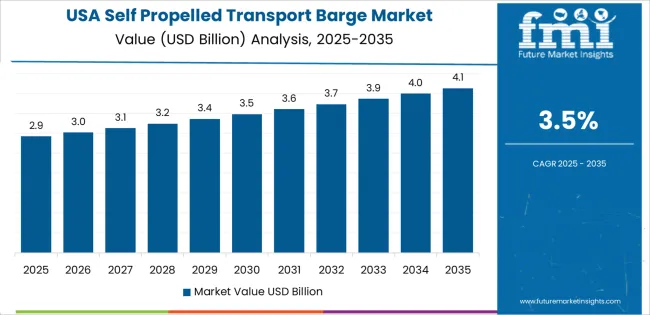
The USA is experiencing steady growth in the self-propelled transport barge market with a 3.5% CAGR, driven by the country’s extensive inland waterway system and growing demand for bulk transportation. The Mississippi River and other major river systems serve as critical trade routes for moving agricultural products, coal, chemicals, and petroleum. Self-propelled barges are integral to these operations, providing an efficient and cost-effective way to transport large quantities of goods over long distances. As the USA continues to prioritize infrastructure investment, including improvements to its waterway network, the demand for self-propelled barges is expected to increase.
With increasing emphasis on environmental sustainability and energy efficiency, water-based transport solutions like self-propelled barges are gaining popularity as an alternative to road and rail transport. The rising cost of land transportation and growing concerns about carbon emissions are driving the shift toward more sustainable freight transport solutions. The continued expansion of the U.S. manufacturing sector and its reliance on bulk materials further drives demand for efficient logistics solutions. As the country looks to improve its supply chains and reduce environmental impact, the market for self-propelled transport barges will continue to grow, offering a reliable solution for freight transportation.
The UK is witnessing moderate growth in the self-propelled transport barge market with a 3.1% CAGR, supported by its increasing adoption of waterborne freight solutions in logistics. The UK’s extensive inland waterways and the importance of river transport for bulk goods like coal, sand, and construction materials make self-propelled barges an essential part of the transportation infrastructure. As the country strives to improve its supply chain efficiency and reduce environmental impact, there is growing demand for alternative modes of transport that are more sustainable, and barges provide an eco-friendly solution to meet this need.
The UK government’s emphasis on reducing carbon emissions and improving the efficiency of its logistics network has contributed to the rising adoption of water transport solutions like self-propelled barges. With the UK’s focus on enhancing infrastructure and adopting greener technologies, water transport is becoming more attractive for transporting bulk goods over long distances. As the country shifts towards more efficient and sustainable logistics solutions, the self-propelled transport barge market is expected to continue growing. With its commitment to sustainability and improving transportation networks, the UK remains a strong player in the European market for self-propelled barges.
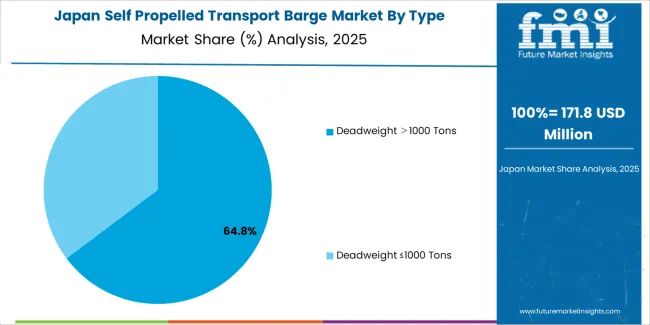
Japan is experiencing steady growth in the self-propelled transport barge market with a 2.8% CAGR, driven by its strong maritime industry and efficient transportation infrastructure. Although Japan’s geography is more reliant on coastal shipping, its inland waterways also play a significant role in transporting bulk commodities such as coal, steel, and agricultural products. Self-propelled barges are particularly useful in Japan’s efficient supply chain system, where quick and cost-effective transportation of goods is critical. The growing emphasis on reducing the environmental impact of transport and logistics is further driving the adoption of barges, as they are more energy-efficient than road or rail transport.
Japan’s well-developed port infrastructure, combined with its ongoing investments in modernizing its logistics systems, supports the continued demand for self-propelled barges. The government’s focus on improving supply chain efficiencies and reducing emissions from transportation also contributes to the market’s growth. As the country works toward sustainable development goals and increases investments in green logistics, the need for energy-efficient transport solutions like self-propelled barges is expected to rise. As industries in Japan continue to expand and modernize their supply chains, the demand for efficient water transport solutions will contribute to steady market growth.

The self-propelled transport barge market is moderately consolidated, with a mix of global shipbuilding leaders and regional specialists catering to the growing demand for efficient cargo transportation in inland and coastal waterways. Damen Shipyards Group leads the market with a 15% share, recognized for its advanced ship designs, high-quality construction standards, and global network of shipyards. Damen’s strong reputation for engineering excellence and innovation in vessel efficiency, propulsion systems, and modular barge construction gives it a competitive edge in this sector.
Other notable players include Kooiman Marine Group, Arena Denizcilik, and Fincantieri Bay Shipbuilding, each offering customized barge solutions tailored to diverse operational needs. Kooiman Marine Group is known for its expertise in ship conversion and specialized vessel design, while Arena Denizcilik focuses on providing reliable coastal and inland transport barges across the European and Middle Eastern regions. Fincantieri Bay Shipbuilding brings decades of experience in commercial shipbuilding, offering large-capacity, fuel-efficient barges for industrial and logistics applications.
Additional contributors to the market include Dredgers Ukraine, NOV, KONGSBERG, and ZPMC, which integrate advanced propulsion, automation, and navigation technologies to improve operational efficiency. Mandovi Drydocks, Peida Machinery Group, and Ratson Shipbuilding strengthen regional competitiveness by offering cost-effective and durable barge solutions. Sabrecraft Marine and Conrad Shipyard are also key participants, focusing on quality craftsmanship and expanding their presence in international markets.
| Items | Values |
|---|---|
| Quantitative Units (2025) | USD billion |
| Type | Deadweight ≤ 1000 Tons, Deadweight > 1000 Tons |
| Application | Cargo Transportation, Marine Engineering, Environmental Management |
| Regions Covered | Asia Pacific, Europe, North America, Latin America, Middle East & Africa |
| Countries Covered | China, Japan, South Korea, India, Australia & New Zealand, ASEAN, Rest of Asia Pacific, Germany, United Kingdom, France, Italy, Spain, Nordic, BENELUX, Rest of Europe, United States, Canada, Mexico, Brazil, Chile, Rest of Latin America, Kingdom of Saudi Arabia, Other GCC Countries, Turkey, South Africa, Other African Union, Rest of Middle East & Africa |
| Key Companies Profiled | Damen Shipyards Group, Kooiman Marine Group, Arena Denizcilik, Fincantieri Bay Shipbuilding, Dredgers Ukraine, NOV, KONGSBERG, ZPMC, Mandovi Drydocks, Peida Machinery Group, Ratson Shipbuilding, Sabrecraft Marine, Conrad Shipyard |
| Additional Attributes | Dollar sales by type and application categories, market growth trends, market adoption by classification and application segments, regional adoption trends, competitive landscape, advancements in self-propelled transport barge technologies, integration with marine logistics and environmental management systems. |
The global self propelled transport barge market is estimated to be valued at USD 6.7 billion in 2025.
The market size for the self propelled transport barge market is projected to reach USD 9.6 billion by 2035.
The self propelled transport barge market is expected to grow at a 3.7% CAGR between 2025 and 2035.
The key product types in self propelled transport barge market are deadweight >1000 tons and deadweight ≤1000 tons.
In terms of application, cargo transportation segment to command 50.0% share in the self propelled transport barge market in 2025.






Our Research Products

The "Full Research Suite" delivers actionable market intel, deep dives on markets or technologies, so clients act faster, cut risk, and unlock growth.

The Leaderboard benchmarks and ranks top vendors, classifying them as Established Leaders, Leading Challengers, or Disruptors & Challengers.

Locates where complements amplify value and substitutes erode it, forecasting net impact by horizon

We deliver granular, decision-grade intel: market sizing, 5-year forecasts, pricing, adoption, usage, revenue, and operational KPIs—plus competitor tracking, regulation, and value chains—across 60 countries broadly.

Spot the shifts before they hit your P&L. We track inflection points, adoption curves, pricing moves, and ecosystem plays to show where demand is heading, why it is changing, and what to do next across high-growth markets and disruptive tech

Real-time reads of user behavior. We track shifting priorities, perceptions of today’s and next-gen services, and provider experience, then pace how fast tech moves from trial to adoption, blending buyer, consumer, and channel inputs with social signals (#WhySwitch, #UX).

Partner with our analyst team to build a custom report designed around your business priorities. From analysing market trends to assessing competitors or crafting bespoke datasets, we tailor insights to your needs.
Supplier Intelligence
Discovery & Profiling
Capacity & Footprint
Performance & Risk
Compliance & Governance
Commercial Readiness
Who Supplies Whom
Scorecards & Shortlists
Playbooks & Docs
Category Intelligence
Definition & Scope
Demand & Use Cases
Cost Drivers
Market Structure
Supply Chain Map
Trade & Policy
Operating Norms
Deliverables
Buyer Intelligence
Account Basics
Spend & Scope
Procurement Model
Vendor Requirements
Terms & Policies
Entry Strategy
Pain Points & Triggers
Outputs
Pricing Analysis
Benchmarks
Trends
Should-Cost
Indexation
Landed Cost
Commercial Terms
Deliverables
Brand Analysis
Positioning & Value Prop
Share & Presence
Customer Evidence
Go-to-Market
Digital & Reputation
Compliance & Trust
KPIs & Gaps
Outputs
Full Research Suite comprises of:
Market outlook & trends analysis
Interviews & case studies
Strategic recommendations
Vendor profiles & capabilities analysis
5-year forecasts
8 regions and 60+ country-level data splits
Market segment data splits
12 months of continuous data updates
DELIVERED AS:
PDF EXCEL ONLINE
Self-Supporting Aerial Optical Cable Market Size and Share Forecast Outlook 2025 to 2035
Self-ligating Metal Brackets Market Size and Share Forecast Outlook 2025 to 2035
Self-ligating Ceramic Brackets Market Size and Share Forecast Outlook 2025 to 2035
Self-sealing Ziplock Bag Market Size and Share Forecast Outlook 2025 to 2035
Self-service Billiards System Market Size and Share Forecast Outlook 2025 to 2035
Self-healing Network Market Size and Share Forecast Outlook 2025 to 2035
Self-administered Biologics Market Size and Share Forecast Outlook 2025 to 2035
Self-fusing Silicone Tape Market Size and Share Forecast Outlook 2025 to 2035
Self-administered Parenteral Market Size and Share Forecast Outlook 2025 to 2035
Self-Adhesive Dual-Cure Luting Cement Market Size and Share Forecast Outlook 2025 to 2035
Self Cooling Packaging Market Size and Share Forecast Outlook 2025 to 2035
Self-service Analytics Market Size and Share Forecast Outlook 2025 to 2035
Self-Compacting Concrete Market Size and Share Forecast Outlook 2025 to 2035
Self-adhesive Tear Tape Market Size and Share Forecast Outlook 2025 to 2035
Self-Adhesive Labels Market Size and Share Forecast Outlook 2025 to 2035
Self-Healing Concrete Market Size and Share Forecast Outlook 2025 to 2035
Self-repairing Polymers Market Size and Share Forecast Outlook 2025 to 2035
Self Cooled Transformer Market Size and Share Forecast Outlook 2025 to 2035
Self Sensing Nanocomposites Market Size and Share Forecast Outlook 2025 to 2035
Self-Lubricating Bearings Market Size and Share Forecast Outlook 2025 to 2035

Thank you!
You will receive an email from our Business Development Manager. Please be sure to check your SPAM/JUNK folder too.
Chat With
MaRIA